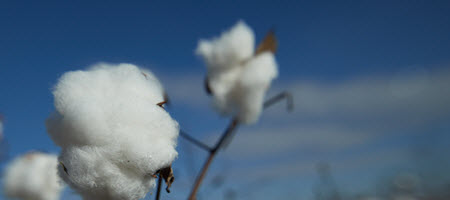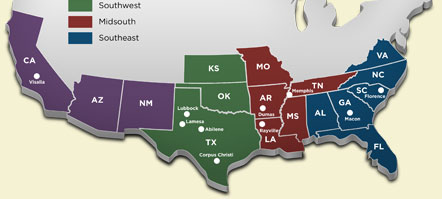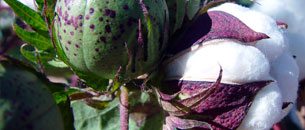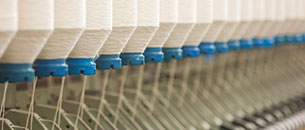The U.S. is the world’s most reliable producer of high quality cotton.
Cotton Incorporated helps maintain this leadership position through ongoing research and measurement studies. These include:
-
Accurate measurements of cotton fiber, yarn and fabric properties.
-
High Volume Instrument testing for fiber length, strength, length uniformity, micronaire, color and trash content.
-
Fiber tests for neps, fineness, maturity, and non-lint content.
-
Management of cotton property databases.
US Cotton Grade Standards
Overview
Overview of the Cotton Classification Process: Nature of Cotton, Classification, Structure, Scope, Process, Tracking.
Maintaining Official Standards for Classification
To maintain the integrity of the USDA classification system, official standards and standardized procedures have been developed and used.
Classification of Upland Cotton
Learn how US Upland Cotton is Classified: Fiber Length, Length Uniformity, Fiber Strength, Micronaire, Color Grade, Trash, Leaf Grade, Extraneous Matter, Module Averaging.
Classification of American Pima Cotton
Classification procedures for American Pima cotton are similar to those for American Upland cotton, including the use of HVI measurements.
Quality and Reliability of Classification Data
The reproducibility of cotton classing results from one USDA facility to another is the measure used to determine the reliability of the data produced.
Dissemination of Data
USDA disseminates data in two formats: (1) official classification information and (2) statistical information regarding quality, volume, and pricing.
Acknowledgements
United States Department of Agriculture and Cotton Council Internatinal Acknowledgements of the Classifications of Cotton.
US Upland cotton crop data for the Far West, Southwest, Midsouth and Southeast cotton growing areas.
Properties of the Growing Regions
View a collection of USDA American Upland cotton crop data from a specific crop season organized by USDA classing office with data totals and averages.
Grades of U.S. Cotton – Official Standards
View a list of each color grade and its symbol for white, light spotted, spotted, tinged and yellow stained American Upland cotton.
Classification of Ratings of Fiber Properties
View a legend of how to interpret fiber property ratings for upper half mean length, fiber elongation, uniformity, fiber fineness, fiber maturity ratio and fiber strength for the fiber chart data.
Bale Sizes
View the average bale weight and average net bale weight; bale size in inches for length, width and thickness at the bale ties listed by gin; and the universal densities System International of units(SI) in meters for American Upland cotton.
HVI® Color Chart
View a chart that shows the graphic plot of the distribution of reflectance (Rd) and yellowness (+b) for American Upland cotton. It includes color grades for white, light spotted, spotted, tinged and yellow stained cotton.
Product Evaluation Lab
Product Evaluation Laboratory (PEL) provides a wide range of standard fiber, yarn, fabric and product tests in support of internal research and marketing efforts and for the cotton breeders working through Cotton Incorporated’s Agricultural Research Division programs.
Every bale of cotton in the United States is classified by The USDA classing offices.
Weekly Cotton Crop Quality Report
These reports provide the most recent quality data for the U.S. cotton crop.
Most Planted Cotton Varieties For 2020
The most planted cotton varieties grown in the United States listed by State.
Final Cotton Crop Quality Summary Reports
These reports provide yearly quality summary data for the U.S. Crop.
Cotton Properties Legend
Definitions for the properties represented in the Cotton Crop Quality reports.
Cotton Crop Quality Summary
A graphical summary chart presentation for the annual upland cotton crop quality.
Using HVI data combined with advanced software allows users to improve spinning processes and end-product quality. Find out how you can better manage your cotton mill or merchant business with Cotton Incorporated’s Engineered Fiber Selection® System Software (EFS®).
MILLNet™ Software
A mill can easily manage the natural variables of cotton with Cotton Incorporated’s MILLNet™ program to produce consistent and uniform laydowns.
US Crop™ Software
The US Crop™ program offers cotton buyers a tool to make informed purchasing decisions.
Cotton Communicator™ Software
The Cotton Communicator™ program is a document translator and manager for handling electronic data interchange (EDI), EWR and UTF-8 text-based documents.
EFS® Technical Service
Cotton Incorporated provides free technical support for all of the EFS® System software products.
EFS® Licensee Yarn Benefits
The benefits fabric manufacturers, garment manufacturers,, and retailers can gain by using the EFS® System.
EFS® Fiber/Yarn Sourcing Directory
View a list of industry-leading textile companies worldwide who use the EFS® System to process millions of cotton bales every year.
Cotton Standards Websites
The purpose of standards is to create a universal system for measuring cotton fiber and product quality.













